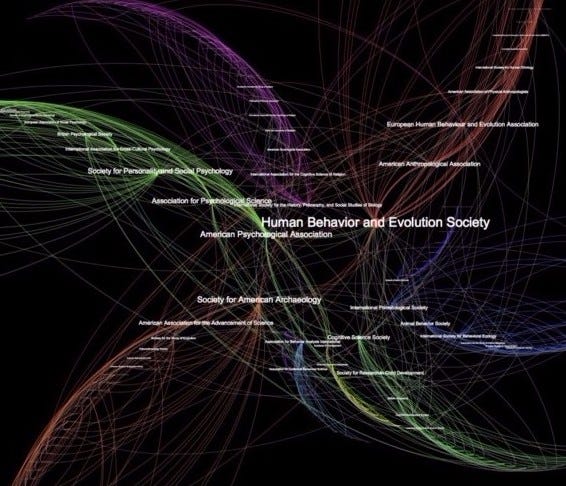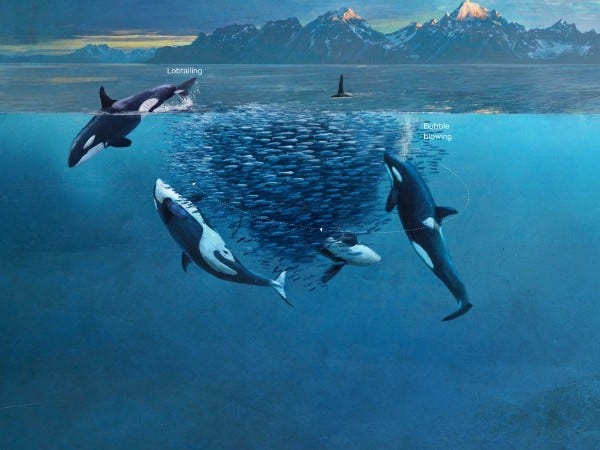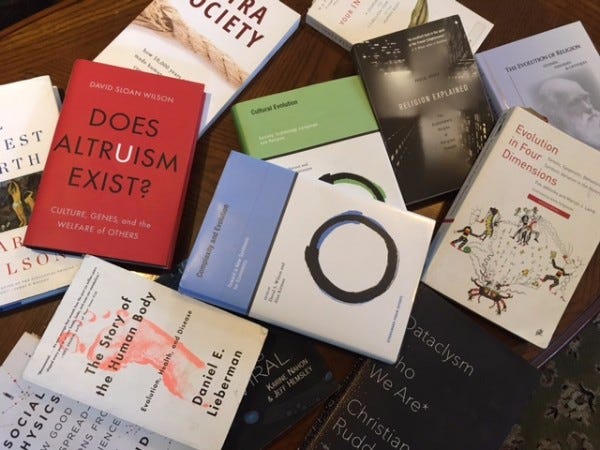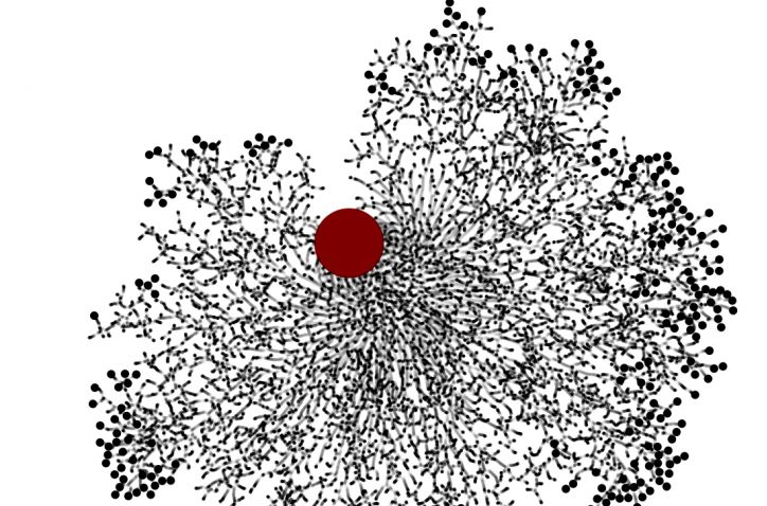We are living in a world where holistic, systemic crises threaten the future of humanity. And yet, there has been an historic pattern of fragmentation in the physical and social sciences needed to tackle them. I have taken on the life mission to guide the evolution of cultural sciences so that they become fully integrated with the dynamics 0f our changing Earth.
The 20th Century saw the rise of many different academic disciplines — anthropology, archeology, economics, history, psychology, philosophy, political science, and sociology — with very little clarity about where one field begins and the other ends. In parallel with this, there has been an explosion of new research fields exploring the digital humanities, human ecology, urban studies, and the inherent patterns of complex systems writ large.
As we grapple with intensifying climate change, rapid depletion of top soils around the world, growing wealth inequality, increasingly decentralized and corrupted media ecosystems, and exponential technologies like artificial intelligence and bioengineering — it is vital that we take stock of all that is already known and quickly integrate the pieces into holistic insights capable of tracking the changes as they unfold.
Nowhere on Earth is anyone doing this in earnest. I should know because seven years ago I was part of the team trying to lay the groundwork for the 120 sciences of the Earth System as part of the International Centre for Earth Simulation (ICES). At the time, that was the most ambitious effort I could find for doing this work. Built on the three pillars of high-performance computing, modeling and simulation, and scientific visualization we were attempting to build a billion dollar research center dedicated to this vital integration work.
While ICES continues to develop in slow progression, another effort is now underway that I have taken the lead on — birthing the Cultural Evolution Society (CES) with the mission to integrate biology with all of the social sciences and humanities. We currently have roughly 2,000 researchers on our mailing list from more than 400 universities in 54 countries around the world. Our first conference will be in a few weeks at the Max Planck Institute for the Science of Human History in Jena, Germany.
I share this because the guided evolution of social science integration will require bridge-building between biology, culture, and ecology. Much groundwork has been laid for this grand synthesis but time is short and it will likely take several decades to bring it to completion. Sadly, humanity doesn’t have the luxury of this much time. We have already crossed at least four of the nine planetary boundaries that define a safe operating range for global civilization. In other words, we are quickly moving into “overshoot-and-collapse” as a planetary species and time is running out.
Read on to learn what we are setting out to do with the field of cultural evolution.
Merging Science with the Humanities

Historical datasets are the “fossil records” for cultural evolution. They are very important! Whether in literature or the arts, humanities researchers hold the key to this massive body of knowledge.
Unfortunately, the tensions between science and humanities are deeply entrenched. Few scholars have bridged across the numerous historic divides. We see our mission of knowledge synthesis as a call to weave the many tools of cultural and social research with the arts and humanities — a two-way street where each side has much to learn from the other.
This interview between David Sloan Wilson and Brian Boyd offers a glimpse of what evolution can offer the arts. It is merely the tip of an iceberg that we can thoroughly explore together in the years to come. Clearly there is a great deal of work to be done here.
Several CES members have already expressed a desire to work closely with the digital humanities. Projects like the Seshat World History Databank provide one such bridge, yet many more will be needed.
A Century of Divided Social Sciences

It is fascinating to learn that evolutionary thinking failed to take hold in both cultural anthropology and sociology for similar historic reasons. A careful study of this history will be necessary if we are to see the emergence of a unified and coherent social sciences in the 21st Century.
If we are to achieve a “grand synthesis” of biology and society (as I’ve written about here), we will need to understand why the divisions exist and where they came from in the first place.
Many institutional factors will also need to be addressed — how to fund interdisciplinary efforts; the challenge of jargon as a linguistic barrier to collaboration; career incentives at odds with integrative approaches; problems with peer-review publications; to name a few.
Again, we really have our work cut out for us. Yet I remain inspired by the incredible diversity of CES members and the interest expressed in tackling these issues together.

A potentially world-changing idea is that every place where social change occurs can become a “field site” for cultural evolution research. This is beautifully articulated in a series of lead articles by Harvey Whitehouse and David Sloan Wilson as it applies to anthropology and biology.
The field site concept has also proven invaluable in fields like archeology, cross-cultural psychology, and sociology. Together we will explore the many variations for how field work is combined with lab studies and theoretical modeling.
Several CES members have expressed concerns about the ethics and politics of applied cultural evolution work. As we build up a community of knowledge and practice with field sites, we will have ample opportunity to explore these vital threads further.
This is another major area to discuss and debate, experiment with and test in the years ahead. Groundwork will need to be laid out in 2017 for this larger effort.
Mapping the State of the Field

Cultural evolutionary studies is a dynamic and rapidly changing field. We will continue mapping out the community assets to reveal patterns and discover opportunities for making progress.
There are hundreds of related professional associations, research centers, academic programs, philanthropic institutions, publications, and so forth spread around the world. Special issues (like this one on the evolution of social behavior in the Journal of Experimental Biology) pop up on a regular basis. Collections of talks recorded as YouTube videos arise from time to time as well (like this one from a recent symposium on biology and culture)
We will continue to curate announcements for meetings and workshops, trainings and conferences, grants and job openings as you send them our way. Scanning social media is another way that we are discovering what is happening in the field, as many of you tweet and blog about gatherings and new published works.
I described the challenge of tracking and absorbing the huge amounts of knowledge in a recent article — this struggle to keep up with the “information deluge” is only going to increase with time.
Embracing Animal Behavior

A great deal of research has been done on the social behaviors of different animals. It will be crucial that we actively promote synergies across these efforts as we also go about the work of studying human cultural evolution.
This study of the way capuchin monkeys make decisions using probabilities (by Daphna Buchsbaum and and Emma Tecwyn) is one example out of hundreds that could be mentioned. A balance needs to be struck between the needed emphasis on the social sciences and humanities — mentioned above — and the broader integrative work that spans the rest of biology.
Care was taken to recruit animal behavior researchers to our Executive Committee. But this is merely the beginning of what will likely be a long road to travel. Providing supports for synergies across animal behavior studies will be a significant task in its own right.
Trainings, Tools, and Libraries

The field of cultural evolution is so rich and diverse that a proper effort will be needed to map out its knowledge ecology. There are hundreds of books, thousands of research articles, dozens of research centers, and numerous ways to begin learning about the science of biological and social change.
Workshops are routinely offered (like this one at the Max Planck Institute in Jena on quantitative methods for the study of language evolution) that students will be interested in. Educational consortiums exist (EvoS being a well-known example) to develop curricula and share teaching practices across universities. Yet there remains an absence of curated and easily navigated training materials for the field as a whole.
With so many tools to use, areas of knowledge to learn about, and possible pathways for career development, it will be helpful to have “platform” solutions that enable these resources to be aggregated, curated, and accessed in a usable manner.
This is another area where CES will have its work cut out for it. Our goal this year is simply to get started and see how far we can go on what promises to be a long journey.
Next Steps — Toward A Grand Synthesis
It is an exciting time to be an interdisciplinary scholar. But it is a scary and dangerous time too. We will become capable of designing cultural change in the midst of crisis when the tools, frameworks, research areas, and learning processes are directed toward holistic insights.
We will need to embrace the complexity of cultural evolution and learn to see the hidden patterns of cultural change. The next five to ten years are going to be filled with disruptions and rapid evolution for technologies, political breakdown and succession, economic transformation, and more. Being prepared will require new practices, institutional structures, and modes of cooperation than those available today.
Underlying all of this will be a move toward the “grand synthesis” of knowledge acquired collectively by humanity in the last five hundred years. We will need to form strategic alliances between funding agencies and philanthropic foundations; forge collaborative trainings and workshops among researchers in networks of social learning across universities and nonprofit research institutes; launch a network of culture design labs that function as field sites for integration of research and practice; and the creation of new educational programs focused on knowledge preservation and synthesis in a time of unprecedented global change.
It’s going to be a wild ride, no doubt about it!
Onward, fellow humans.





